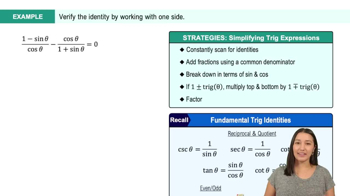Table of contents
- 0. Review of College Algebra4h 43m
- 1. Measuring Angles39m
- 2. Trigonometric Functions on Right Triangles2h 5m
- 3. Unit Circle1h 19m
- 4. Graphing Trigonometric Functions1h 19m
- 5. Inverse Trigonometric Functions and Basic Trigonometric Equations1h 41m
- 6. Trigonometric Identities and More Equations2h 34m
- 7. Non-Right Triangles1h 38m
- 8. Vectors2h 25m
- 9. Polar Equations2h 5m
- 10. Parametric Equations1h 6m
- 11. Graphing Complex Numbers1h 7m
6. Trigonometric Identities and More Equations
Introduction to Trigonometric Identities
Problem 5.24a
Textbook Question
For each expression in Column I, use an identity to choose an expression from Column II with the same value. Choices may be used once, more than once, or not at all.
sin 300°
 Verified step by step guidance
Verified step by step guidance1
Step 1: Recognize that 300° is in the fourth quadrant of the unit circle.
Step 2: Recall that the sine function is negative in the fourth quadrant.
Step 3: Use the identity for sine: \( \sin(360° - \theta) = -\sin(\theta) \).
Step 4: Apply the identity: \( \sin(300°) = \sin(360° - 60°) = -\sin(60°) \).
Step 5: Identify that \( \sin(60°) = \frac{\sqrt{3}}{2} \), so \( \sin(300°) = -\frac{\sqrt{3}}{2} \).
Recommended similar problem, with video answer:
 Verified Solution
Verified SolutionThis video solution was recommended by our tutors as helpful for the problem above
Video duration:
0m:0sPlay a video:
Was this helpful?
Key Concepts
Here are the essential concepts you must grasp in order to answer the question correctly.
Trigonometric Identities
Trigonometric identities are equations that involve trigonometric functions and are true for all values of the variables involved. They are essential for simplifying expressions and solving trigonometric equations. Common identities include the Pythagorean identities, angle sum and difference identities, and double angle identities, which can help relate different angles and their sine, cosine, and tangent values.
Recommended video:

Fundamental Trigonometric Identities
Reference Angles
A reference angle is the acute angle formed by the terminal side of an angle in standard position and the x-axis. For angles greater than 180° or less than 0°, the reference angle helps determine the sine and cosine values by relating them to angles in the first quadrant. For example, the reference angle for 300° is 60°, which allows us to find sin 300° using the known value of sin 60°.
Recommended video:

Reference Angles on the Unit Circle
Unit Circle
The unit circle is a circle with a radius of one centered at the origin of a coordinate plane. It is a fundamental tool in trigonometry, as it provides a geometric interpretation of the sine, cosine, and tangent functions. By using the unit circle, one can easily find the values of these functions for any angle, including those greater than 360° or negative angles, by determining the coordinates of the corresponding point on the circle.
Recommended video:

Introduction to the Unit Circle

 6:19m
6:19mWatch next
Master Even and Odd Identities with a bite sized video explanation from Callie Rethman
Start learningRelated Videos
Related Practice
















